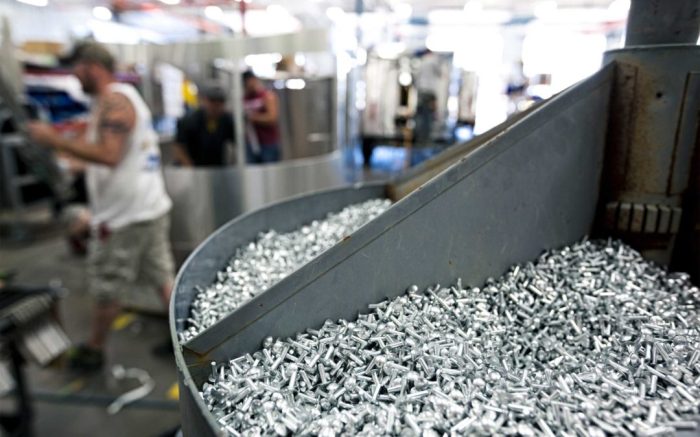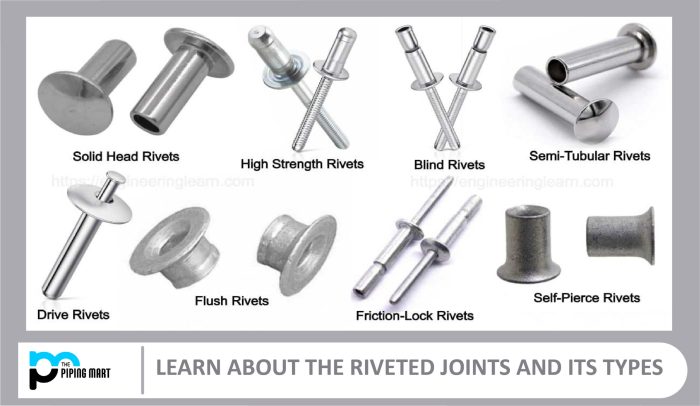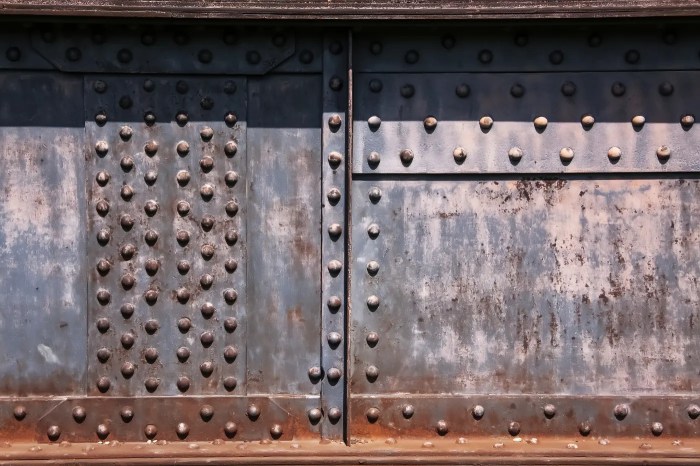Mild steel rivets are used for riveting – Mild steel rivets are extensively used in various industrial applications, offering a robust and reliable solution for permanent joint formation. Their exceptional strength, durability, and ease of installation make them a preferred choice for a wide range of riveting needs.
This comprehensive guide delves into the properties, riveting techniques, and applications of mild steel rivets, providing valuable insights for engineers, fabricators, and professionals involved in metalworking industries.
Riveting with Mild Steel Rivets
Mild steel rivets are commonly used for riveting applications due to their strength, durability, and cost-effectiveness. They are often employed in various industries, including construction, manufacturing, and automotive.
The process of riveting involves joining two or more pieces of material together using a rivet. Mild steel rivets are inserted into pre-drilled holes and then deformed to create a permanent joint. This technique provides a secure and reliable connection that can withstand various loads and stresses.
Advantages of Using Mild Steel Rivets for Riveting, Mild steel rivets are used for riveting
- High strength and durability
- Resistance to corrosion and wear
- Cost-effective compared to other riveting materials
- Easy to install and remove
- Versatile and suitable for a wide range of applications
Applications of Mild Steel Rivets
- Construction: Joining structural steel beams, bridges, and other load-bearing components
- Manufacturing: Assembling machinery, appliances, and other industrial equipment
- Automotive: Fabricating car bodies, frames, and other automotive parts
Properties of Mild Steel Rivets: Mild Steel Rivets Are Used For Riveting

Mild steel rivets are made from a low-carbon steel alloy, typically containing less than 0.25% carbon by weight. This composition provides a balance of strength, ductility, and weldability.
The mechanical properties of mild steel rivets vary depending on their carbon content and heat treatment. However, typical properties include:
- Tensile strength: 400-500 MPa
- Yield strength: 250-350 MPa
- Elongation at break: 20-30%
Impact of Carbon Content on the Properties of Mild Steel Rivets
The carbon content in mild steel rivets significantly affects their properties. Higher carbon content increases the strength and hardness of the rivets but reduces their ductility and weldability.
For applications requiring high strength and wear resistance, rivets with higher carbon content may be preferred. However, for applications where ductility and weldability are important, rivets with lower carbon content are more suitable.
Grades of Mild Steel Rivets
Mild steel rivets are available in various grades, each with specific properties and applications. Some common grades include:
- A307: General-purpose rivets with good strength and ductility
- A325: High-strength rivets for structural applications
- A490: Ultra-high-strength rivets for critical load-bearing applications
Riveting Techniques

There are several riveting techniques used with mild steel rivets, including:
- Hand riveting: Using a hammer and anvil to deform the rivet
- Machine riveting: Using a riveting machine to apply force and deform the rivet
- Orbital riveting: Using a rotating tool to deform the rivet around its circumference
The choice of riveting technique depends on the application, the size and number of rivets, and the available equipment.
Step-by-Step Instructions on How to Rivet with Mild Steel Rivets
- Prepare the materials: Gather the mild steel rivets, drill bits, and riveting tools.
- Drill the holes: Drill holes in the materials to be joined, ensuring the holes are aligned and the correct size for the rivets.
- Insert the rivet: Insert the rivet into the holes, with the head of the rivet facing the outside.
- Deform the rivet: Use the riveting tool to deform the rivet’s tail, creating a second head on the opposite side of the materials.
- Inspect the joint: Check the joint to ensure it is secure and the rivets are properly deformed.
Safety Precautions to Consider When Riveting with Mild Steel Rivets
- Wear appropriate safety gear, including gloves and safety glasses.
- Use the correct riveting tool for the job and ensure it is in good working condition.
- Keep the work area clean and free of debris.
- Do not attempt to rivet with damaged or weakened rivets.
- Be aware of the potential for sparks and hot metal during the riveting process.
Applications of Mild Steel Rivets

| Application | Industry | Advantages |
|---|---|---|
| Structural steel fabrication | Construction | High strength, durability, and resistance to corrosion |
| Automotive body assembly | Automotive | Lightweight, cost-effective, and easy to install |
| Machinery and equipment assembly | Manufacturing | Versatility, resistance to wear, and ability to withstand high loads |
Alternatives to Mild Steel Rivets
While mild steel rivets are widely used, there are alternative materials that can be considered for riveting applications.
Some common alternatives include:
- Stainless steel rivets: Offer higher corrosion resistance and strength
- Aluminum rivets: Lightweight and resistant to corrosion, but softer than mild steel
- Copper rivets: Excellent electrical conductivity and resistance to corrosion
- Plastic rivets: Lightweight, non-conductive, and suitable for low-load applications
Factors to Consider When Choosing Between Mild Steel Rivets and Alternative Materials
- Strength requirements
- Corrosion resistance
- Weight
- Electrical conductivity
- Cost
By carefully considering these factors, engineers and designers can select the most appropriate material for their specific riveting application.
Common Queries
What are the advantages of using mild steel rivets?
Mild steel rivets offer several advantages, including high strength, durability, resistance to corrosion, ease of installation, and cost-effectiveness.
What are the different riveting techniques used with mild steel rivets?
Common riveting techniques for mild steel rivets include hand riveting, machine riveting, and blind riveting.
What are the safety precautions to consider when riveting with mild steel rivets?
Safety precautions include wearing appropriate protective gear, ensuring proper ventilation, and handling rivets with care to avoid injuries.